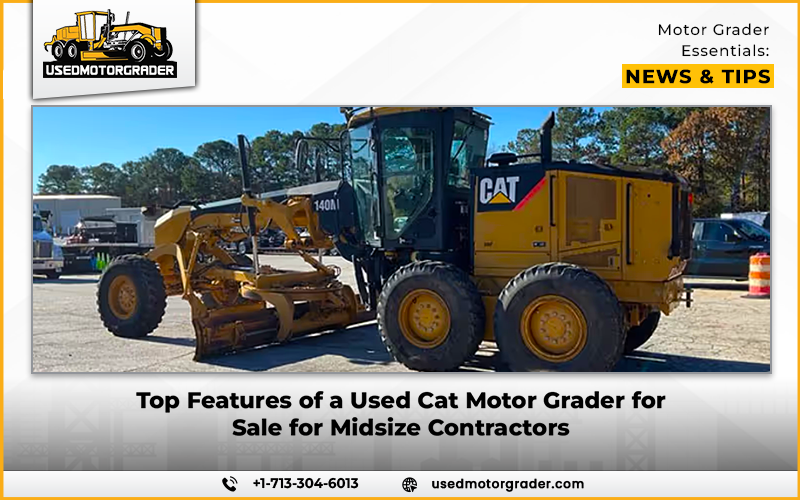When it comes to purchasing a used cat motor grader for sale, mid-sized contractors often walk a tightrope between cost and capability. They need a machine that can handle a broad range of grading tasks, from road maintenance to site prep, without straining their capital or leading to long-term maintenance headaches. That’s why knowing which features to prioritize and which red flags to watch for, is critical. A well-chosen used grader can become a dependable, profit-generating asset for years to come, but only if the right evaluation criteria guide the purchase.
Engine Hours vs. Machine Condition: Reading Between the Numbers
Engine hours are often the first number buyers look at, but they’re not the full story. A machine with 7,000 hours could be in far better condition than one with 4,500 if it were properly maintained and used for light-duty work. That’s why mid-sized contractors should go beyond the hour meter. Service logs, oil analysis records, and ownership history can provide a much more accurate picture of how the machine has aged. Look for signs of consistent care, regular fluid changes, documented repairs, and operator notes. Also, consider idle time. Some newer CAT machines track idle hours separately, giving better insight into actual working time.
Blade Condition and Cutting Edge Wear: Don’t Overlook the Work Tool
The blade might seem easy to replace, but excessive wear on it can tell a deeper story about how the grader was operated. Uneven wear, chipped cutting edges, or obvious pitting may indicate aggressive use or poor technique. A worn blade also raises questions about the condition of the moldboard and the circle drive. These components play a key role in precision grading, and damage here can lead to costly repairs. When evaluating a used cat motor grader for sale, always inspect the blade assembly closely. If the wear doesn’t match the listed engine hours or the machine’s age, that inconsistency deserves attention.
Hydraulic System Health: Smooth Operation or Hidden Risk?
Few systems affect day-to-day grading performance as directly as hydraulics. Smooth articulation, blade lift, and tilt depend on a healthy hydraulic circuit. That’s why any used cat motor grader for sale inspection should include a hands-on hydraulic test. Look for delayed movement, spongy responses, or any signs of fluid leaks around cylinders and hoses. Excessive whining or jerky motion could indicate pump wear or contamination in the system. For mid-sized contractors, who often depend on one machine to handle multiple projects, downtime due to hydraulic failure can be a major blow, so it’s wise to prioritize a grader with a well-functioning, responsive hydraulic system.
Transmission and Articulation: The Backbone of Worksite Maneuverability
CAT graders are known for their torque-rich transmissions and tight articulation, both of which are critical for navigating confined job sites or shaping complex slopes. When test-driving a used unit, pay close attention to how the transmission shifts under load. Slipping, hesitation, or hard shifts could be a sign of internal wear. Similarly, check articulation by turning the machine lock-to-lock; any grinding, stiffness, or audible clicking could mean bushing or pin issues. These components aren’t just about comfort; they’re essential for control. For mid-sized crews who rely on one operator to get it right the first time, a smooth transmission and tight articulation make a huge difference.
Tier Rating and Emissions Tech: What to Know Before You Buy
In today’s regulatory environment, emissions compliance is more than a checkbox; it can impact where and how you operate. CAT graders span a range of emissions tiers, and mid-sized contractors need to know what they’re buying. Tier 3 machines, which predate complex DEF systems, are often prized for their simplicity and reliability, but they may not be allowed in certain states or municipalities. Tier 4 Final models meet the latest standards but come with more emissions equipment that can drive up service costs. If your jobs take you across state lines or into urban areas, make sure the grader’s emissions package aligns with current and future compliance needs.
Grade Control Systems and Cab Tech: Optional or Essential?
For mid-sized contractors, deciding whether to pay extra for integrated grade control or advanced cab features can be tricky. Some models offer basic 2D systems, while others come with fully integrated GPS-ready automation. If your work regularly involves fine grading or highway slope work, grade control can dramatically improve productivity and reduce rework. On the flip side, if your team works mostly on rural roads or construction pads, a well-trained operator might not need it. As for the cab, comfort and visibility shouldn’t be dismissed. Fatigue leads to mistakes, and a well-designed cab can make long days more manageable and safer for operators.
Buying Smart, Not Just Cheap
Ultimately, buying a used CAT motor grader should be a strategic decision, not just a hunt for the lowest price. Mid-sized contractors, in particular, must think in terms of lifecycle value. Will the machine still serve you three years down the line without draining your budget in maintenance? Does it match the complexity your team can handle without outside tech support? Is it versatile enough to serve multiple job types throughout the season? A little more spent upfront on a well-maintained unit with solid bones often saves more in the long run than a bargain machine that’s already halfway through its useful life. It’s not about getting the cheapest grader, it’s about getting the right one.


